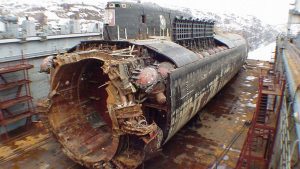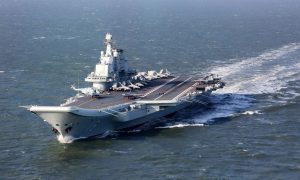| Its designers thought the Yamato was indestructible, but Japan’s military planners sent the battleship on a one-way journey to death. |
| Japan’s Yamato battleship was assigned a one-way trip to death in World War Two. Indeed, Yamato’s suicide mission is one of the saddest stories of the war in the Pacific. The largest battleship in the world had only enough fuel to reach its destination – it did not have enough for a return voyage home. Its mission was to fight against a large American force of battleships and carriers. It ultimately suffered an inferno of destruction, with almost all hands drowning during the Battle of Okinawa in 1945.
The orders from Japan’s high command look ridiculous in hindsight. The Yamato was supposed to fight its way to Okinawa, beach itself, and serve as a fortress with a huge contingent of powerful guns – blasting away until it could fight no more. Fleet Commander Vice-Admiral Seiichi Ito was on board, and he must have accepted his grim fate with steadfast bravery. But he would die along with 3,054 sailors when the ship sank. Only 276 personnel survived the Ten-Go Operation. The history of the Yamato goes back to the 1930s, when Japan began building a fleet meant to dominate its neighbors. The Imperial Navy, and famed ship builders Yuzuru Hiraga and Kikuo Fujimoto, examined 23 designs for a super ship. The engineers knew that at a bare minimum they wanted three triple turrets to hold nine 18-inch guns that would fire shells weighing 1.5 tons. At the time, these were the biggest armaments ever devised. An impressive number of six-inch guns adorned the deck as well. The ship was 862 feet long and 127 feet wide. It could carry three to five reconnaissance airplanes. Designers also planned for aerial bombardment. They made the main armor deck thick enough to withstand the punishment of heavy bombs dropped from high altitude. Sixteen inches of armor were placed around the ship, and the Japanese thought it was indestructible. Yet the armor was not strong along the bow and stern, and this proved to be the Yamato’s undoing. The ship did not have an extensive combat record, so the crew was relatively inexperienced for its final mission. That day in April 1945 began with the Yamato leading nine other ships. With no carrier in the vicinity, there was no air cover, so the Yamato was steaming “naked.” Four hundred American bombers and torpedo carriers converged on the battle group 270 miles north of Okinawa. The U. S. Navy was determined to attack the biggest target, and planes dropped 1,000-pound bombs on the Yamato. The battleship and its escorts fought back, but cloud cover favored the Americans – the Japanese anti-aircraft guns could not easily locate enemy airplanes. The Yamato turned repeatedly to avoid the bombs, but the torpedo bombers proved to be too much to overcome. Wave after wave of U. S. Navy pilots went for the weak spots – sending the torpedoes toward the Yamato’s bow and stern, below the waterline. The main damage was on the ship’s port side, and the crew thought it could contain the damage while fighting like heck against the marauding airplanes. But torpedoes probably struck the magazines, causing massive explosions that created two large holes, sinking the ship. Japanese war historians regularly recount the sad death of the Yamato, often relaying the story of the Japanese emperor’s orders for the mission. The destroyed ship was discovered and examined by dive crews in 1985 and 1999, providing a stark reminder of the horrors of war. Now serving as 1945’s Defense and National Security Editor, Brent M. Eastwood, PhD, is the author of Humans, Machines, and Data: Future Trends in Warfare. He is an Emerging Threats expert and former U. S. Army Infantry officer. You can follow him on Twitter @BMEastwood. |






